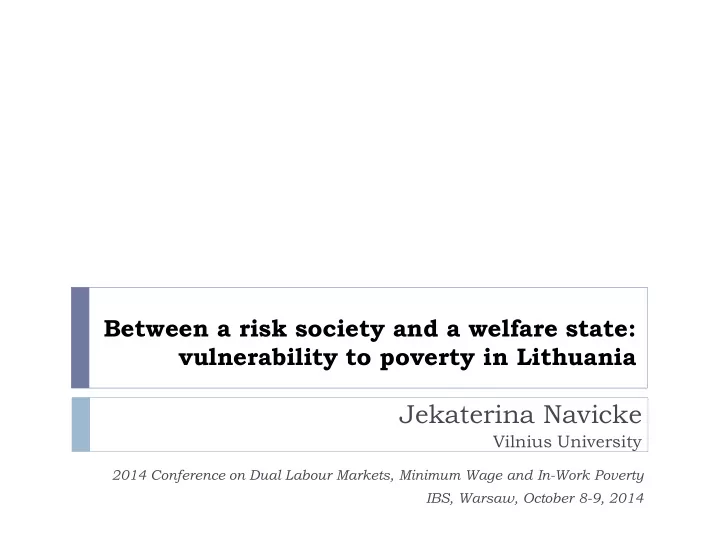

Between a risk society and a welfare state: vulnerability to poverty in Lithuania Jekaterina Navicke Vilnius University 2014 Conference on Dual Labour Markets, Minimum Wage and In-Work Poverty IBS, Warsaw, October 8-9, 2014
Outline Aim Theoretical background Measuring vulnerability using microsimulation Results for Lithuania: unemployment and childbirth
Aim Analysis of the role tax-benefit system plays in mitigating the effects of wide spread socio-economic risks: links between risk, welfare state development, vulnerability measures focusing on vulnerability and social protection
Risk society, welfare state & vulnerability Risk society thesis (Beck 1992, 2009, etc.) ‘Democratic’ risks Individualisation & responsibilisation in social protection Welfare state’s role: re -distribution of risk rather than resources Through risk society lenses retrenchment of welfare provisions can be interpreted as a shift towards individualisation and promotion of more active, flexible and adaptive engagement with risk and individual responsibility (Kemshall 2002) Concerns: partial/biased knowledge & uncertainty ‘democratisation’ of risks is questionable multiple and cumulative effects of poverty and disadvantage
Implications Weakening of the protective / re-distributive function of the welfare state Increasing individual vulnerability to poverty Did the weakening of social protection go unnoticed during economic boom? Ways of timely monitoring of the resilience of tax-benefit system?
Measuring vulnerability Vulnerability analysis: the magnitude of risk measured ex-ante centrality of social protection vulnerability viewed as welfare-reducing Macro and micro level measures (& mixed): Macro: country’s proneness to shocks, ability to recover Micro: individual vulnerability as exposure to risk as income volatility as expected poverty
Atkinson (2009) on vulnerability analysis: Performance of tax-benefit systems ex- ante: ‘stress - testing’ Usefulness of microsimulation techniques Focus on acute income shocks rather than volatility Followed up by Figari et al. (2011), Fernandez Salgado et al. (2013) on the welfare compensation for unemployment.
Application Vulnerability as expected poverty Stress testing – simulating income loss due unemployment & childbirth: Microsimulation model EUROMOD (version G1.0) EU-SILC 2008 and 2010 data Lithuanian policies of 2007-2012 (before, during and after crisis) Indicators of vulnerability reflect expected incidence and intensity of poverty risk within one year after the income loss Scope: population of insured individuals and household members Simulated income shock: one household member at a time, all possible combinations within the household Standard Foster-Greer-Thorbecke (FGT) poverty measures with a probabilistic term :
Lithuanian context: 2007-2008 rapid economic growth, financial recession of 2009-2010 and first signs of recovery since 2011 Changes to major cash benefits: generous child/family protection 2007-2009, temporary cuts to social benefits in 2010-2011, some restored Unemployment, child and family benefits subject to cuts within the period
Context: unemployment & fertility
Context: unemployment & migration
Results (I)
Results (II)
Results (III)
To sum up: no need to wait for a new crisis Welfare state’s role: towards promotion of individual responsibility for risk management; protection/re-distribution need to stay in focus. Using vulnerability measures for monitoring: focus on social protection, on expected poverty rather than volatility, ex-ante measures. ‘Stress - testing’ using microsimulation for vulnerability analysis. In Lithuania for unemployment and childbirth: imbalances in vulnerability levels produced by the welfare state policies lack of the counter-cyclical social protection traditional mutual support among the household members plays a major role, despite of the diminishing importance noted in the literature Potential for using stress testing: scope for improvement measures: more risks and more elaborate measures comparative vulnerability analysis – EUROMOD model covers EU27
Thank you! Navicke, J. (2014) Paper: Between a risk society and a welfare state: social risk resilience and vulnerability to poverty in Lithuania. EUROMOD Working Paper No. EM 4/14: https://www.iser.essex.ac.uk/research/publications/working- papers/euromod/em4-14.pdf Contacts: Jekaterina Navicke, j.navicke@yahoo.com
Using stress testing to measure vulnerability Advantages and limitations of using microsimulation: complex evaluation of the functioning of the tax-benefit system socio-demographic structure of the population ex-ante analysis of the latest policy changes reliability of data in the small population sub-groups static simulation – first round effects assumption of full benefit take-up and compliance to tax rules
Results (III)
Recommend
More recommend